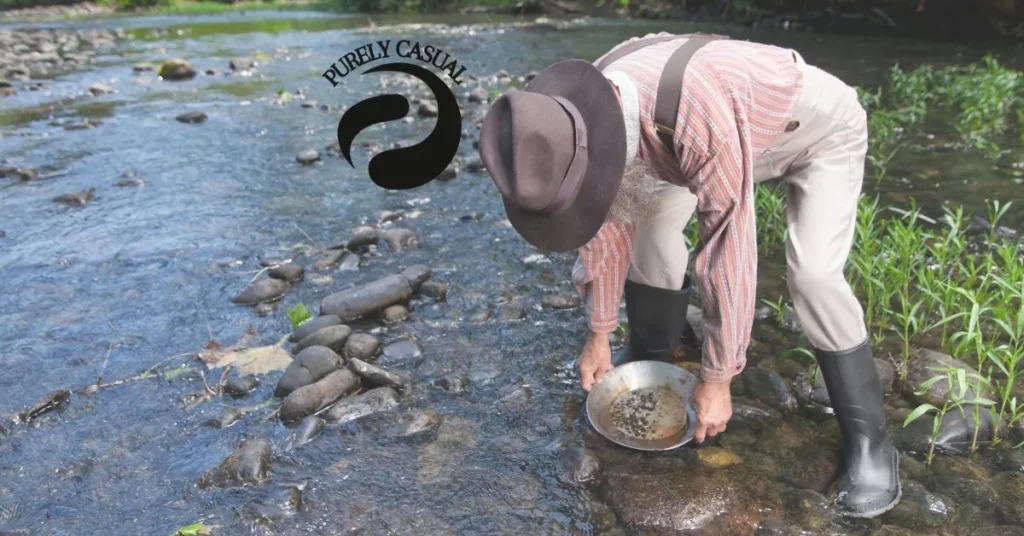Gold panning, or “mendulang emas,” offers a unique blend of excitement and patience. For those eager to strike gold, understanding the principles of gold panning and maintaining an orderly approach is key to success. This guide will take you through every step of the process, ensuring you maximize your gold panning experience.
Table Of Contents
Getting Ready for Gold Panning
Essential Tools: Before setting out, equip yourself with the right tools:
- Gold Pan: Opt for a pan with a shallow, round design and sloped sides. Plastic pans are easier to handle, while metal pans offer greater durability. The sloped sides facilitate the separation of gold from sediment by allowing heavier particles to settle.
- Sieve or Classifier: This tool, featuring a mesh screen, is used to sift out larger rocks and debris from the sediment. Using a sieve ensures that only finer material, where gold is more likely to be, reaches your pan.
- Container: Choose a bucket or container with a secure lid to collect your gold and other findings. A lid helps prevent accidental spills and keeps your finds protected.
- Shovel or Trowel: A small shovel or trowel is crucial for scooping sediment from the riverbed and transferring it into your gold pan.
Dress Appropriately: Wear clothing that suits outdoor work. Sturdy, waterproof boots are essential for navigating slippery riverbeds. Gloves protect your hands from rough materials and potential injuries. A wide-brimmed hat and sunscreen are vital for sun protection, especially if you plan to be out in the open for extended periods. Consider wearing layered clothing that you can adjust based on the weather.
Finding the Right Spot
Research Locations: The success of gold panning often depends on choosing the right location. Look for areas with historical significance or known gold deposits. Gravel bars, river bends, and places where streams slow down are ideal spots. Use online resources, maps, or local knowledge to identify promising locations. Historical mining records can also provide valuable insights into where gold has been found in the past.
Prepare the Site: Once you’ve identified a suitable location, ensure it is safe and practical for panning. Avoid areas with strong currents, deep water, or unstable ground. Set up your workspace away from heavy traffic to minimize disturbances. A good site will offer easy access to sediment, and the area should be comfortable for working.
How to Pan for Gold
Collecting Sediment: Use your shovel or trowel to gather sediment from the riverbed. Aim for a mix of gravel and sand to increase your chances of finding gold. Start with a manageable amount—about halfway full in your pan. Too much sediment can make the process cumbersome and less effective.
Swirling and Washing: Submerge the pan in water and gently shake it back and forth. This motion allows the heavier gold particles to sink to the bottom of the pan. Tilt the pan slightly to let the lighter sediment wash away. Repeat this process until only a small amount of residue remains. The goal is to separate the gold from other materials, so patience and careful handling are crucial.
Refining Your Search: As you continue to wash away the lighter material, closely examine the remaining sediment. Gold, being denser, will settle at the bottom of the pan. Use a small brush or your fingers to gently separate any gold from the remaining debris. This step requires a keen eye and a steady hand, as even tiny gold flakes can be valuable.
Keeping Everything Clean and Organized
Maintain a Tidy Workspace: A clean and organized workspace helps you work more efficiently and reduces the risk of losing gold. Lay out your tools neatly and keep your gold pan free of excess sediment. Regularly empty and clean your container to prevent contamination and ensure that your findings are accurately recorded.
Regular Cleaning: Frequently clean your hands and tools to avoid transferring unwanted materials. This is especially important when moving between different panning areas. Thoroughly rinse your pan to remove any residual sediment, which helps maintain the purity of your finds and ensures that your equipment remains in good condition.
Patience and Precision
Work Slowly: Gold panning requires a methodical approach. Take your time with each step to avoid missing any gold. Rushing can lead to errors and a loss of potential finds. Every small movement counts, so work slowly and carefully to maximize your chances of success.
Document Your Findings: Keep a detailed record of where you find gold and any observations about the sediment or location. Note patterns or specific characteristics of successful areas. This documentation can help you refine your technique and improve your future gold panning efforts. Tracking your progress and results provides valuable insights that can enhance your skills over time.
Safety First
Respect the Environment: Minimize your environmental impact by following local regulations and guidelines for gold panning. Avoid disturbing wildlife or damaging natural habitats. Practice responsible panning by cleaning up your workspace and leaving no trace of your activities. Respecting the environment ensures that others can enjoy the same natural beauty and resources.
Stay Safe: Be vigilant around water bodies. Watch for slippery rocks, strong currents, and other potential hazards. Ensure you have a safe exit plan in case of sudden changes in conditions or if you encounter difficulties. Always prioritize your safety and be prepared for emergencies.
Conclusion
Practicing “tertib ketika mendulang emas,” or maintaining order and discipline while gold panning, is crucial for a successful and enjoyable experience. By preparing thoroughly, choosing the right location, and working with precision, you enhance your chances of finding gold and ensure a rewarding adventure. Embrace the process with patience, attention to detail, and respect for the environment. With these practices, you might discover the hidden treasures you seek. Enjoy your gold panning journey and happy prospecting!
FAQs
How do I choose the best location for gold panning?
Look for areas with historical gold deposits, such as gravel bars, river bends, and slow-moving streams. Research local gold panning sites or historical mining records to identify promising locations.
What is the best way to clean a gold pan?
Rinse your gold pan with water after each use. For stubborn residue, use a brush to scrub the pan. Ensure that you clean the pan thoroughly when moving between different areas to avoid mixing sediment.
How can I improve my chances of finding gold?
Work slowly and carefully, using a methodical approach. Document your findings and observe patterns or successful techniques. Experiment with different locations and techniques to increase your chances of finding gold.
What should I do if I find a significant amount of gold?
Secure your gold in a safe container and consider having it assessed by a professional. Follow local regulations regarding the reporting of valuable finds to ensure you comply with legal requirements.







